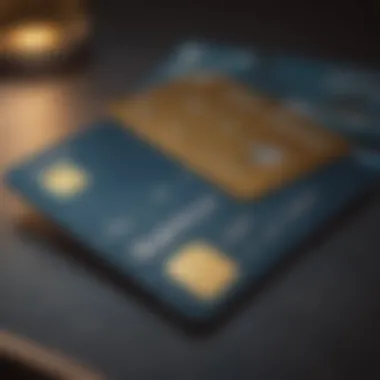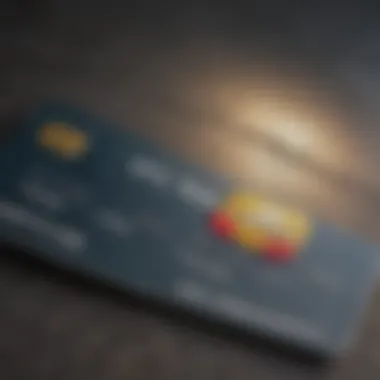Cash Out Virtual Credit Cards: Process & Implications


Intro
Virtual credit cards have emerged as a novel solution for many consumers and businesses seeking to enhance their transaction security. These digital cards allow users to make payments online while minimizing exposure to potential fraud. Understanding the process of cashing out these virtual credit cards is essential for maximizing their benefits. This article delves into this process, revealing methods, potential advantages, and disadvantages.
Understanding Credit Status
Cashing out virtual credit cards often relates to an individual's credit status. This section will explain the essentials of credit status and its significance.
What is Credit Status?
Credit status is a measure of an individual’s creditworthiness. It offers insights into how likely someone is to repay borrowed funds. Factors influencing this status include existing debt, payment history, and credit usage.
Key Factors Affecting Credit Scores
Several elements impact credit scores:
- Payment History: Continual on-time payments boost your score.
- Credit Utilization: Using too much of your available credit can negatively affect your score.
- Length of Credit History: A longer history can enhance your credit score.
- Types of Credit Accounts: A diverse range of credit types can be beneficial.
- Recent Credit Inquiries: Too many inquiries within a short time can harm your score.
Importance of Knowing Your Credit Reports
Understanding your credit reports is vital. These reports offer detailed insights into your financial behavior. Regular review can help you identify errors and manage your credit effectively.
How to Obtain Your Credit Reports
To gain access to your credit reports, you can:
- Visit AnnualCreditReport.com for a free report once a year.
- Check with your bank or credit card issuer, as many provide free scores.
- Use services like Credit Karma for ongoing monitoring.
Cashing Out Virtual Credit Cards
Knowing your credit status is important when considering cashing out virtual credit cards. Understanding how to navigate this process effectively can influence financial decisions.
Practical Steps for Cashing Out
The cash-out process involves a few straightforward steps:
- Link your virtual card to a payment app: Services like PayPal allow you to withdraw funds easily.
- Transfer to a physical card: Some providers allow transfers from a virtual account to a physical card.
- Use direct bank transfers: Depending on the issuer, direct bank transfers might be an option.
Various Methods Available
Different transaction methods may apply:
- Digital wallets: Platforms like Google Wallet or Apple Pay facilitate easy transfers.
- Bank wire transfers: Traditional banks often provide these services.
- Check issuance: Some card providers offer check issuance for balance cash-out.
Potential Advantages and Disadvantages
Cash-out methods have both benefits and downsides:
Advantages:
- Increased security during transactions.
- Limits exposure to fraud.
Disadvantages:


- Possible fees for withdrawals.
- Limitations on cash-out amounts.
Security Protocols on Virtual Credit Cards
Security measures associated with virtual credit cards must also be considered. Here, the concern focuses not just on cashing out but on safety during usage.
Insights into Security Protocols
Virtual credit cards employ various security protocols, such as:
- Temporary card numbers: These change with each transaction to protect against fraud.
- Encryption technology: Securing user data during transactions ensures safety.
Regulatory Considerations
As virtual payment solutions grow, regulatory frameworks are adapting. Users must stay informed about these regulations to ensure compliance and security.
Culmination
Understanding the process of cashing out virtual credit cards is key for anyone involved in personal or business finance. With a secure and smart approach, users can navigate this arena effectively.
Prelims to Virtual Credit Cards
Virtual credit cards have become increasingly relevant in today's digital economy. The significance of this topic lies in addressing the evolving landscape of online transactions and the demand for security and convenience. Understanding virtual credit cards is crucial for anyone engaged in financial management, both for personal and business purposes.
Definition and Purpose
A virtual credit card is a digital representation of a physical credit card. It typically comes with a unique card number, expiration date, and security code, allowing users to make online purchases securely. The primary purpose of virtual credit cards is to enhance transactional security. By using a virtual card, individuals protect their personal card details from potential breaches.
Virtual credit cards are often linked to a bank account or a credit line. They facilitate online spending without exposing the actual card information. This protects users from fraud and reduces the risk of identity theft. They serve as a useful tool for managing online subscriptions or purchasing from websites that may not be trustworthy.
How Virtual Credit Cards Differ from Traditional Ones
Virtual credit cards offer distinct advantages when compared to traditional credit cards. Firstly, they eliminate the need for a physical card, making them ideal for online usage. Users can generate new card numbers for different transactions, thereby increasing anonymity.
Another key difference is the control they offer. With virtual cards, users can often set limits and expiration dates. This user-defined control adds an extra layer of security, as it can help prevent unauthorized charges.
Additionally, virtual cards can be issued instantly, which is a notable contrast to the traditional credit card application process that can take several days. This immediate availability can be advantageous in urgent situations when time is critical.
Understanding the Cash-Out Process
Understanding the cash-out process for virtual credit cards is essential for maximizing their usability and benefits. This topic encompasses the methods through which users can convert their virtual card funds into cash or transfer them to traditional bank accounts. Knowing how to effectively cash out is significant as it opens up a flexible approach to managing finances, whether for personal use or business expenses. The implications of this process involve understanding both the advantages it brings and potential challenges users may face.
Step-by-Step Guide to Cashing Out
Cashing out from a virtual credit card involves several important steps. Initially, users should check their balance and ensure they have access to the necessary funds. After confirming the amount available, it's crucial to review the terms set by the issuing bank or financial service, as different institutions might have various rules regarding cashing out. Once these aspects are clear, users can choose their preferred cash-out method and proceed accordingly, ensuring they keep track of transactions for their records.
Common Methods for Cashing Out
Cashing out funds from virtual credit cards can be accomplished through different methods. Each option presents unique characteristics and advantages that might fit specific needs.
Transferring Funds to Bank Accounts
Transferring funds to bank accounts is a widely used method for cashing out virtual credit cards. This approach is straightforward and fits well within the overall financial ecosystem of digital transactions. One key characteristic of transfers is their convenience; users often find it easy to manage funds directly from their bank accounts. The unique feature of this method lies in its efficiency—once set up, transferring can be done quickly, offering timely access to funds. However, users must also pay attention to any potential transfer fees, which could impact the total amount they receive in their accounts.


Using ATMs
Using ATMs provides another practical method for cashing out. This option is particularly beneficial for individuals who require immediate access to cash. ATMs allow users to withdraw funds directly without the need to wait for transfers. A significant characteristic of this method is its directness; users can instantly obtain cash as needed. Nonetheless, it is worth noting that ATM withdrawals may come with transaction fees, particularly if the user is operating outside of their bank's network, which could diminish the amount available for cash.
Third-Party Cash-Out Services
Third-party cash-out services offer an alternative avenue for users looking to access funds from their virtual credit cards. Services such as PayPal or Venmo can facilitate users in receiving cash quickly. The key characteristic of these services is their accessibility; they tend to have user-friendly platforms where cash-out transactions can occur seamlessly. Furthermore, many people find these platforms familiar, making the transition feel easy. However, one must be aware of the potential fees associated with using third-party services, which can decrease the effectiveness of this option depending on the amount being cashed out.
"Understanding your cash-out options for virtual credit cards can greatly enhance your financial flexibility."
Advantages of Cashing Out Virtual Credit Cards
Cashing out virtual credit cards can offer various significant benefits,able to enhance the user experience and financial management. Consumers often turn to virtual credit cards as they navigate their online transactions. However, understanding the advantages of cashing out these cards is crucial. It can make a significant difference in how individuals and businesses manage their finances.
Increased Flexibility
One of the most appealing aspects of cashing out virtual credit cards is the increased flexibility they provide. This flexibility allows users to access their funds quickly and efficiently, catering to a variety of spending needs. Unlike traditional credit cards, the process for cashing out virtual cards often permits a range of cash withdrawal options.
For example, users can transfer funds directly to their bank accounts or use ATMs to obtain cash instantly. This can be particularly useful in scenarios where immediate liquidity is necessary. Furthermore, with many service providers offering various cash-out mechanisms, users can often choose the method that works best for them—ensuring that financial resources are available whenever needed.
Enhanced Security
Security is a paramount concern in the realm of financial transactions. Cashing out virtual credit cards can involve enhanced security measures that protect users from potential fraud or unauthorized access. Virtual credit cards typically generate unique card numbers for each transaction, reducing the risk of exposing personal information.
When cashing out, the use of secure platforms for fund transfers adds a layer of safety. Many virtual card providers implement advanced encryption and authentication protocols, which can include two-factor authentication and transaction alerts. These features create a secure environment for financial activities, reassuring users that their funds are adequately protected.
Access to Online Transactions
Virtual credit cards offer seamless access to online transactions, which can be a game-changer for both consumers and businesses. The ability to use cash obtained from virtual cards for online spending opens doors to numerous opportunities. Users can make purchases, pay for services, or even manage subscriptions without hassle.
Moreover, this contributes to a broader financial strategy. Users can swiftly adapt to a rapidly changing marketplace, where online shopping and digital transactions are increasingly prevalent. Cashing out virtual credit cards provides not only immediate financial power but also positions users favorably in the digital economy. By leveraging these cards, individuals and companies can interact with the online marketplace efficiently.
Cashing out virtual credit cards provides improved flexibility, security, and access to online transactions, making it an appealing option for modern financial management.
Potential Drawbacks
Cashing out virtual credit cards can come with its own set of challenges. Recognizing these potential drawbacks is essential for anyone considering this financial maneuver. Understanding the limitations and risks involved can help users make informed decisions. This section will cover three main aspects of potential drawbacks: fees associated with cashing out, limitations on cash-out amounts, and fraud risks.
Fees Associated with Cashing Out
One significant concern when cashing out virtual credit cards is the potential for incurring fees. These fees can vary based on the method of cashing out chosen, such as using ATMs or transferring funds to a bank account. In some cases, service providers might charge transaction fees or withdrawal fees.
- ATM Fees: Many ATMs charge a fee for transactions, which can reduce the cash you receive when you withdraw.
- Transfer Fees: If you decide to transfer funds to your bank account, there could be fees from either the service or your bank.
- Service Charges: Third-party cash-out services often have their own fee structures, which can include both flat fees and percentages of the amount being cashed out.
Being mindful of these fees is crucial in determining whether cashing out the virtual credit card is financially viable. Users need to account for these costs as they can significantly reduce the amount accessible after cashing out.
Limitations on Cash-Out Amounts
There are typically restrictions on how much can be cashed out at one time or within a specific period. These limitations can be imposed by the card issuer or financial institutions. This may lead to inconveniences for users needing to access large sums of money quickly. Understanding these caps before initiating a cash-out is essential.
For example, some cards may limit cash withdrawals to a certain percentage of the total available balance or set a daily withdrawal limit. Users should check specific terms and conditions associated with their virtual credit card. If one needs to access more funds, this can require multiple transactions or additional planning.
Fraud Risks and Security Concerns


While virtual credit cards offer enhanced security compared to traditional ones, the process of cashing out still presents risks. Fraud can be an issue, especially if personal information is not handled securely. Here are a few key concerns related to fraud and security:
- Phishing Scams: Users may fall victim to scams that aim to capture sensitive information. Always ensure communications are from trusted sources.
- Unauthorized Access: If proper security measures are not in place, unauthorized individuals may try to access funds or details.
- Reputation of Service Providers: Not all third-party cash-out services have the same level of security. It’s vital to choose reputable services to mitigate risks.
Regulatory and Compliance Considerations
Understanding the regulatory and compliance landscape surrounding virtual credit cards is essential for users navigating this financial tool. As digital payments grow, regulators are establishing rules to protect consumers and ensure integrity in financial transactions. Knowledge of these regulations helps cardholders to effectively manage their virtual credits while minimizing risks.
Understanding Financial Regulations
Financial regulations provide a framework for safe operation in the credit card industry, including virtual credit cards. There are several key regulations to be aware of:
- Anti-Money Laundering (AML): These regulations require financial institutions to monitor transactions to prevent money laundering activities. Virtual credit card providers must have protocols in place to detect suspicious activities.
- Know Your Customer (KYC): This process involves verifying the identity of customers to combat fraud. Users may need to provide personal information when applying for a virtual credit card.
- Consumer Financial Protection Bureau (CFPB): This agency oversees the enforcement of consumer rights in financial transactions. Understanding its guidelines helps consumers assert their rights effectively.
Awareness of these regulatory aspects ensures that users do not fall prey to fraudulent services and can utilize their virtual cards within the outlined legal frameworks.
Consumer Rights and Protections
Consumer rights in financial transactions safeguard individuals in the event of fraud or misuse. Some critical rights related to virtual credit cards include:
- Fair Access to Credit: Consumers should have access to various financial products, including virtual credit cards, without discrimination.
- Right to Dispute Charges: If unauthorized transactions occur, users have the right to dispute them and seek refunds.
- Privacy Protection: Regulations enforce how personal information must be handled. Consumers should ensure their providers comply with privacy laws to protect their data.
By understanding these rights, users are better equipped to protect themselves against potential financial misconduct while using virtual credit cards. Knowledge fosters confidence, leading to more informed users who can navigate the complexities of digital finance.
Informed consumers are better poised to leverage the benefits of financial tools while maintaining compliance with applicable regulations.
Best Practices for Using Virtual Credit Cards
Understanding the best practices for using virtual credit cards is essential in maximizing benefits while mitigating risks. These cards are becoming widely accepted, yet their correct management demands certain attention. Employing effective strategies can enhance both your financial security and user experience in various transactions.
Managing Limits and Usage
Effective management of limits and usage is crucial when handling virtual credit cards. First, understanding the specific limit for each card is essential. Some cards may allow a high daily spending limit, while others impose a stricter cap. Knowing these limits can help prevent unnecessary declines during transactions. Additionally, it is wise to use virtual credit cards for online purchases. This way, you can allocate specific funds to each transaction. By doing so, you can minimize the impact on your overall credit balance and manage your financial exposure.
Another important aspect involves setting spending alerts. These notifications inform you when you approach your limit, providing further control over your finances. Utilizing these tools can assist in budgeting and prevent overspending, which leads to debt issues. Users should also periodically review their spending patterns. This practice helps identify any discrepancies or unauthorized transactions. It is also a good idea to regularly update spending limits based on your financial situation and needs.
Ensuring Security and Privacy
Maintaining security and privacy is paramount with virtual credit cards. These cards are inherently safer due to their disposable nature, but certain practices can further enhance protection. Start with using unique passwords for every account where virtual cards are stored. Password managers can simplify the creation and management of strong passwords. Encrypting sensitive information, when possible, also provides an additional layer of security.
Make sure to register for alerts about transactions. Whenever a transaction occurs, you should receive instant notifications. This practice serves as an early warning system if any unauthorized activities take place. Using secure networks when shopping online is another critical point. Avoid using public Wi-Fi; instead, opt for a trusted network.
Security measures are essential, for even virtual cards can become a target for malicious actors.
Lastly, ensure the website is secure (look for
End
Summary of Key Insights
In summary, cashing out virtual credit cards is a multifaceted process that carries several implications for users. One key insight is that this mechanism offers flexibility in managing funds, allowing individuals and businesses to convert credits into cash for practical use. Understanding the cash-out process is essential. Familiarity with steps involved ensures users can navigate effectively, minimizing errors and avoiding potential pitfalls. Moreover, being aware of associated fees can help users make informed decisions about when and how to cash out, thereby maximizing financial efficiency.
The advantages highlighted include increased security and reduced fraud risks, which is especially relevant in today’s digital economy. The ability to monitor transactions regularly adds an additional layer of safety, essential for effective credit management. These insights combine to create a framework for understanding how virtual credit cards fit into a broader financial strategy and how users can leverage them for personal or business purposes.
Future of Virtual Credit Card Usage
Looking ahead, the landscape of virtual credit card usage is poised for change. Advances in technology will continue to influence how these cards function. One foreseeable development is the integration of artificial intelligence to enhance security. This could help detect and prevent unauthorized transactions more effectively, thus bolstering user confidence.
There is also a growing trend toward regulatory bodies adapting their policies to keep pace with digital financial instruments. As virtual credit cards become more prevalent, ensuring consumer rights and protections will become increasingly important. This evolution may lead to clearer guidelines on fees, cash-out limits, and security protocols.
As more businesses adopt virtual credit card systems, we might see innovations in cash-out methods, making it easier for users to access their funds. For example, partnerships with fintech companies could streamline procedures and reduce the time taken for cash transfers. Ultimately, the future holds great potential, but users should stay informed about changes and adapt to the evolving environment surrounding virtual credit cards.







